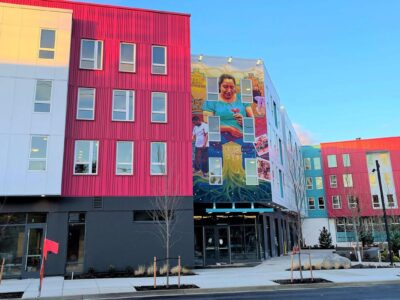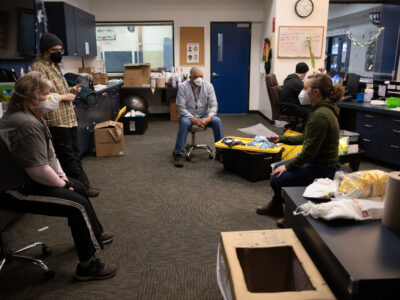The Multnomah Services and Screening Tool (MSST)
Coordinated Access Redesign
The Joint Office of Homeless Services is leading a redesign of the local Coordinated Access tool and process. The process helps identify people in our community with the most immediate need and highest housing barriers and connect them with permanent and supportive housing.
What is Coordinated Access?
Coordinated Access is a system to help unhoused people connect with permanent and supportive housing. The system prioritizes people with the highest housing barriers to our limited housing resources. Coordinated Access connects many service providers in one central system. Our local system covers Multnomah County and the cities of Portland and Gresham.
The U.S. Department of Housing and Urban Development (HUD) requires a Coordinated Access system for any community that receives federal funding — which includes the Joint Office. As the agency in charge of our local Coordinated Access system, the Joint Office is required by HUD to have a Coordinated Access system.
What is the Coordinated Access Redesign?
Before the redesign, Multnomah County’s Coordinated Access System used the VI-SPDAT (Vulnerability Index Service Prioritization Decision Assistance Tool) to prioritize people for housing services.
Over the last three years, the Joint Office has been working to redesign the Coordinated Access tool. The improved tool — called the Multnomah Services and Screening Tool (MSST) — is based on feedback from key stakeholders, including people with lived experience of homelessness and local service providers, as well as local data.
The MSST is shorter and easier to understand than the previous tool. The questions on the form are more trauma-informed. They align with local priorities. And they promote equity in access to available housing resources.
Households who fill out this assessment and receive placement on our community’s “priority housing list” will also now fill out a Housing Preferences & Matching Questionnaire — another new tool produced through the redesign that helps identify suitable housing resources.
In addition, another step — with attached resources — has been added to support households who are facing a housing crisis but whose scores do not rank high enough to be placed in the priority housing pool.
How will it work?
The first step is for a person or family in need of housing to connect with a trained assessor who conducts an assessment of needs and risks and fills out a Multnomah Services and Screening Tool (MSST) assessment.
- Completed MSST forms are scored, and households are prioritized according to their highest housing barriers. Based on available housing inventory, prioritized households are added to the “priority housing pool.”
- Households placed in the priority housing pool will complete a Housing Preferences & Matching Questionnaire to find the most suitable available housing resources for their needs. They will also receive support in gathering necessary documents as they wait for a housing program referral. Now, instead of just being “placed on the list” (the old system), households will receive a realistic timeline for when they can expect to move into housing.
- Households whose scores on the MSST are not high enough to be placed in the priority housing pool will be offered Housing Problem Solving, which helps to identify other solutions for those households’ housing crisis. The goal is to help households draw on alternative community and personal resources to resolve their housing crisis as quickly as possible.
Instead of creating a running list of everyone who has completed a Coordinated Access assessment, the new process will place the households with the greatest housing barriers in the priority housing pool. The size of the priority housing pool will be continually readjusted to match the number of households who can realistically be housed by Coordinated Access resources expected to be available in the next six months. Because system capacity fluctuates, the scoring threshold and the number of households who enter the priority housing pool will be evaluated and adjusted based on available resources at a given time.
In addition, the Joint Office will engage the community to regularly evaluate the new assessment tool and process. Updates will be incorporated as needed to ensure the new process meets the community’s needs.
Why redesign Coordinated Access?
The Joint Office is committed to continuous quality improvement and to proactively reviewing its work and processes so they can work better for more people.
As part of that commitment, the Joint Office found that the previous tool it used for Coordinated Access (the VI-SPDAT) did not go far enough to address issues of equity and to identify and prioritize people in the most need of immediate support. So the office worked to design an assessment tool and process that is more equitable, trauma-informed and streamlined. The creation of this new assessment tool was guided by people with lived experience of homelessness and homeless service providers.
What is ‘Housing Problem Solving’?
The new assessment tool formally adds a process called Housing Problem Solving. The goal of Housing Problem Solving is for households to have in-depth problem-solving conversations with the trained assessor, helping the household explore personal and community housing solutions that might be available to them. Assistance may include coaching, conflict resolution, mediation, connections to mainstream services, housing search and planning, and sometimes limited financial assistance for immediate needs.
Housing Problem Solving offers alternatives to households who may not receive any other formal assistance through the system. It helps preserve housing resources for households with the highest housing barriers and no alternative options, while making sure that everyone seeking assistance is offered some form of help in resolving their housing crisis.
Limited financial assistance can sometimes make the difference in Housing Problem Solving. As part of the Coordinated Access redesign, the Joint Office and Multnomah County will making flexible funds available to assist households with Housing Problem Solving.
What isn’t changing with the redesign?
The redesign unfortunately cannot change the shortage of available affordable housing in our community. It also does not change the fact that need continues to exceed available resources.
But what it can do is make better use of what’s currently available, while the Joint Office, Multnomah County and the City of Portland work together — through the Homelessness Response Action Plan — to make other improvements and address our housing shortage.
The Coordinated Access redesign intentionally focuses on equitably and efficiently connecting households who have the highest housing barriers to the available participating housing programs.
The redesign also will not change who is eligible for specific housing programs. Different programs may have different eligibility criteria, and while the redesign works to prioritize households with the highest barriers to housing, some programs have certain restrictions based on funding or program type that will not change through the redesign.





